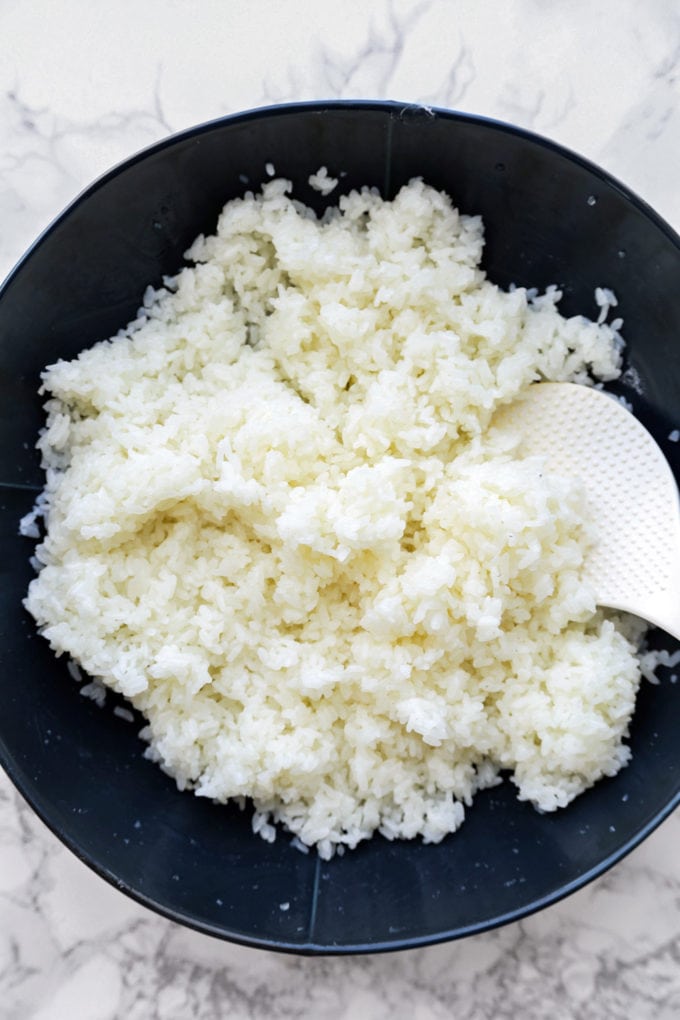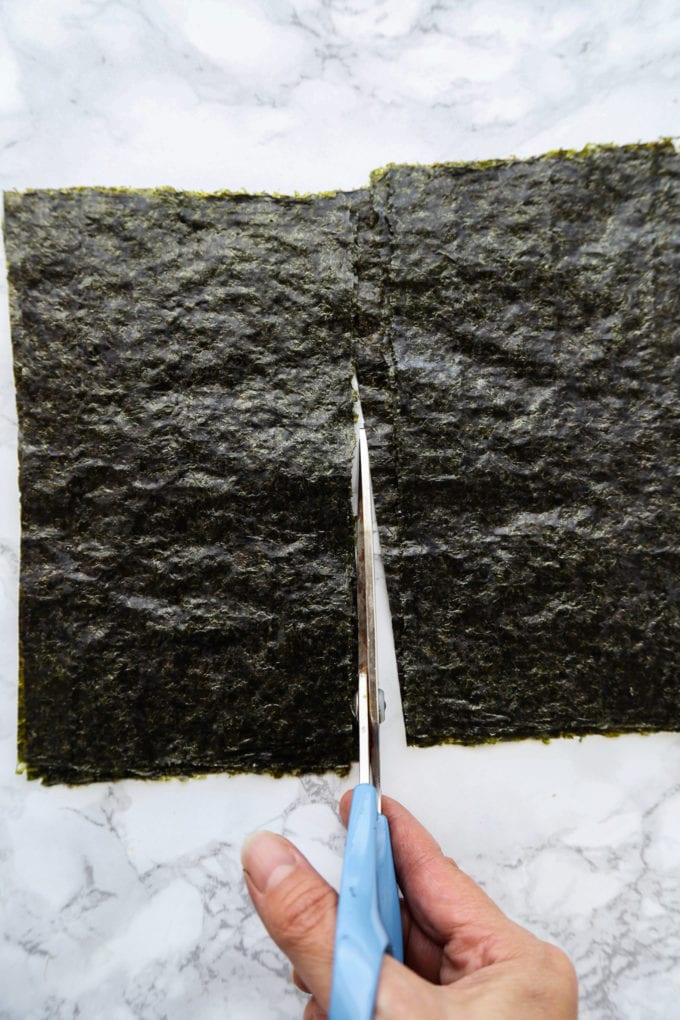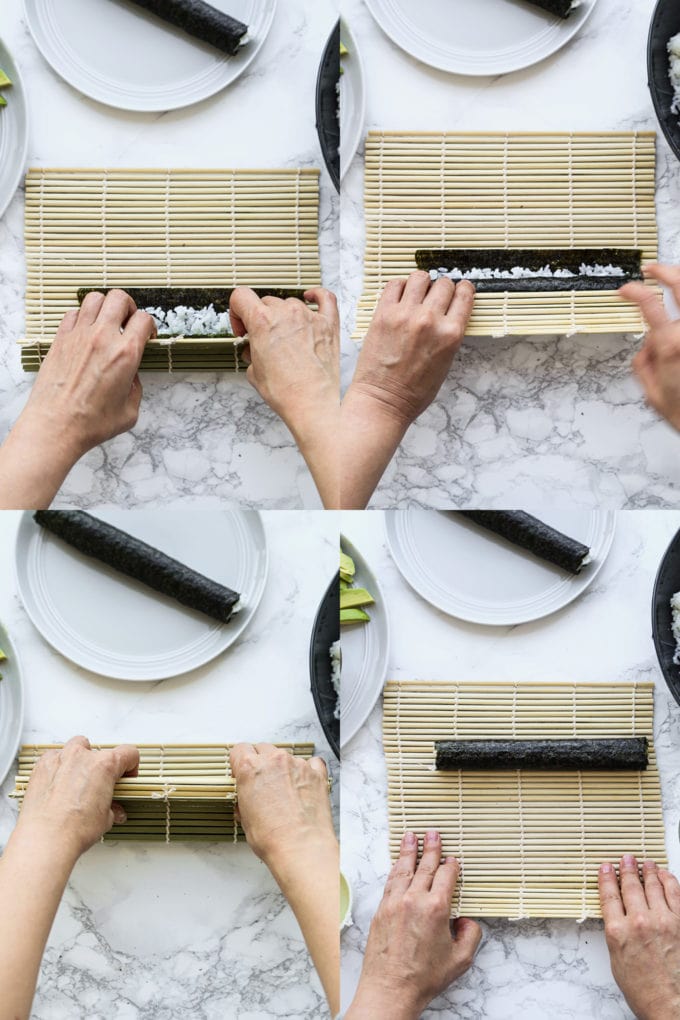Maki sushi are so much fun to eat! Light and filled with various fillings, these mini sushi rolls are always a crowd pleaser in my kitchen!
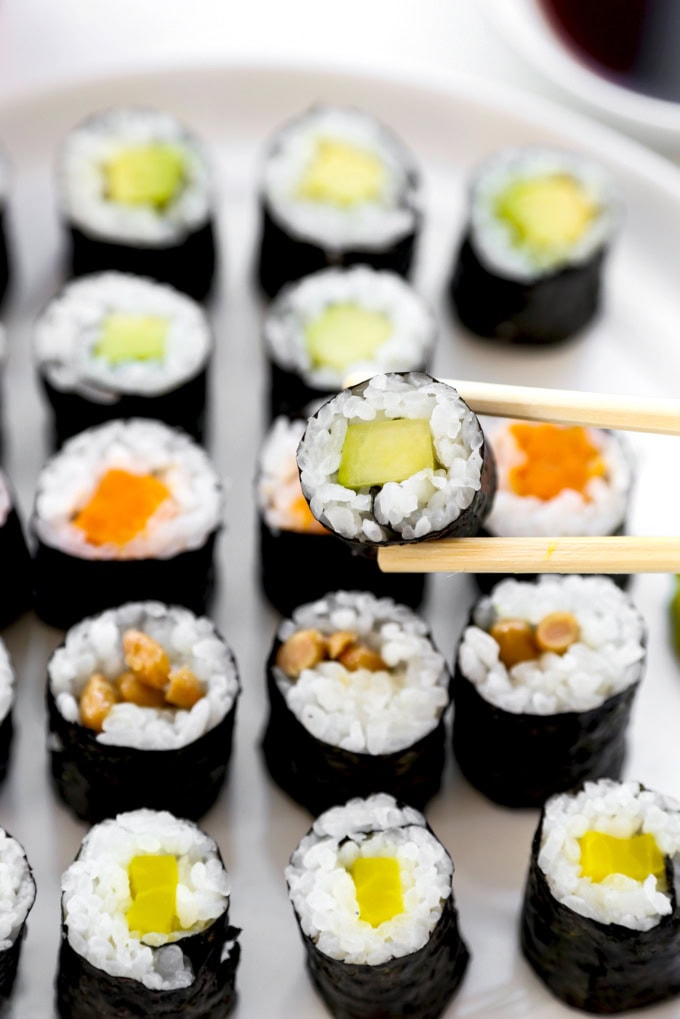
What is Maki Sushi?
Maki sushi are sushi rolls that come with various fillings in the center. Basically, if the sushi you eat is wrapped in nori, it’s a maki roll. The word maki is Japanese for “roll”.
Different types of Maki Sushi
There are many different types of maki sushi available and the most popular ones are:
- Hosomaki (細巻き): This is the one I’m making in this post. It’s a mini sushi roll containing only one filling.
- Nakamaki (中巻き): Nakamaki is similar to hosomaki but bigger because it contains 2-3 ingredients in the center (e.g., California roll).
- Futomaki (太巻き): Futomaki is similar to nakamaki but fatter because it contains 4-5 ingredients in the center (e.g., spider roll).
- Temaki (手巻き): Called hand roll in English, temaki is the only maki that’s cone shaped so it can be carried around by hand.
- Gunkan maki (軍艦巻): Called warship roll for its battleship-like shape, this maki is oval shaped and has a strip of nori wrapped around the circumference of the rice. It’s topped with luxurious ingredients such as ikura (salmon roe) and uni (sea urchin).
- Uramaki (裏巻き): This one is a little different than the others because the nori is on the inside, while the rice is on the outside of the roll.
To learn more about the different types of sushi available, check out my post: Nigiri vs Musubi vs Maki vs Sushi vs Sashimi – What is the difference?
Ingredients for Maki Sushi
- Sushi rice: A mix of cooked short grain Japanese rice, rice vinegar, sugar, and salt. Make sure you use short grain Japanese rice and not medium grain! Short grain is much stickier than medium grain and is the difference between good sushi and bad sushi.
- Nori: Look for plain nori sheets (roasted seaweed) that are around 7″x8″ in size. You will be cutting them in half to make maki rolls.
- Fillings: You can technically use any type of filling to make maki sushi, there are no wrong ways to make it! If you’d like to stick mainstream rolls, use ingredients such as sushi grade tuna (tekka maki), yellowtail (hamachi maki), or salmon (sake maki), cucumber (kappa maki), avocado (avocado maki), pickled plum (ume maki), pickled gourd (kanpyo maki), pickled daikon (takuan maki), or fermented soybean (natto maki). I’m using cucumber, takuan (pickled daikon), cooked sweet potato, avocado, and natto for my maki rolls.
- Extras: You don’t necessarily need the extras to enjoy maki rolls but I do recommend having the option to dip them in soy sauce and wasabi, and to have about a tablespoon of pickled ginger on the side to chew on, as a palate cleanser.
Essential Tools To Make Sushi At Home
There are a few tools you will need to make sushi rolls from scratch. You can find them at your local Japanese supermarket, in some Asian grocery stores, or you can order them online.
Short grain Japanese rice
Essential to making good maki rolls.
Seriously, if you can only find medium grain Japanese rice, please wait until you get your hands on short grain Japanese rice. Medium grain rice should never be used to make sushi. That’s because there is a big difference in texture – short grain is much stickier than medium grain and therefore makes it easier for the rolls to hold their shape.
Look for Koshihikari short grain rice or the Tamanishiki brand, which is the one I use.
Rice Cooker
Not essential but something to seriously consider if you cook a lot of rice like I do.
I’ve made rice on the stove and rice in a rice cooker and I hate to say it but the machine wins every single time. My rice comes out perfectly fluffy and it’s not just for Japanese rice – there’s a function for brown rice, jasmine, and multigrain rice.
I use mine 4-5 times a week and not just for rice! Some rice cookers like the one I have offer other functions like Slow Cook, Steam, and Bake. I make anything from quinoa, to soups, to stews, even carrot cake!
Aside from my blender and water heater, my rice cooker/multi cooker is the most used appliance in my kitchen. All rice cookers come with a rice paddle so you don’t have to buy one separately.
Sushi rice mixing tub (hangiri)
This is optional, you could use a mixing bowl like I do but there are some advantages to having a hangiri for sushi making – it absorbs moisture from the rice and the shallow depth means the rice will cool faster.
Bamboo mat
While a hangiri isn’t a must for making sushi at home, a bamboo mat, called makisu in Japanese (巻き簾), is. You will need it to roll the sushi into a neat little cylinders.
Rice paddle
A good rice paddle is also highly recommended for mixing the rice vinegar, sugar, and salt, and folding the rice to let the excessive moisture escape.
How to Make Maki Sushi
- Make the sushi rice by combining freshly cooked Japanese short grain rice, rice vinegar, sugar, and kosher salt. Toss and fold the rice to combine the ingredients.
- Place a bamboo mat on a flat surface with the bamboo strips parallel to you so the mat can be rolled upward and away from you.
- Fill a bowl with tepid water and about 1 tablespoon rice vinegar. Place it next to the mat, along with the sushi rice and various fillings.
- Slice the nori sheets in half, lengthwise, and place them on a plate next to the bamboo mat.
- Let’s make maki sushi now – grab a sheet of nori and lay it lengthwise on the bamboo mat. Leave a few bamboo strips free at the front it.
- Dip your fingers in the vinegar water and scoop up a loose half cup of sushi rice. Place the sushi rice over the nori sheet and spread it across evenly, using your fingers. Leave about an inch of nori space free on the side furthest away from you (where you will finish rolling).
- Place the filling of your choice in the middle of the rice, lengthwise, parallel to you. Grab the bottom edges of the mat with your thumbs and index fingers and hold on to the filling with your middle and fourth fingers. Roll it into a tight cylinder, tucking the filling in firmly.
- Roll the mat forward slowly, while using a little pressure but not so much that the filling spills out. Let go of the mat when you get to the other end.
- Wet the knife with a little vinegar water and cut the roll into bite size pieces.
- Serve with wasabi and soy sauce for dipping, and pickled ginger as a palate cleanser between bites.
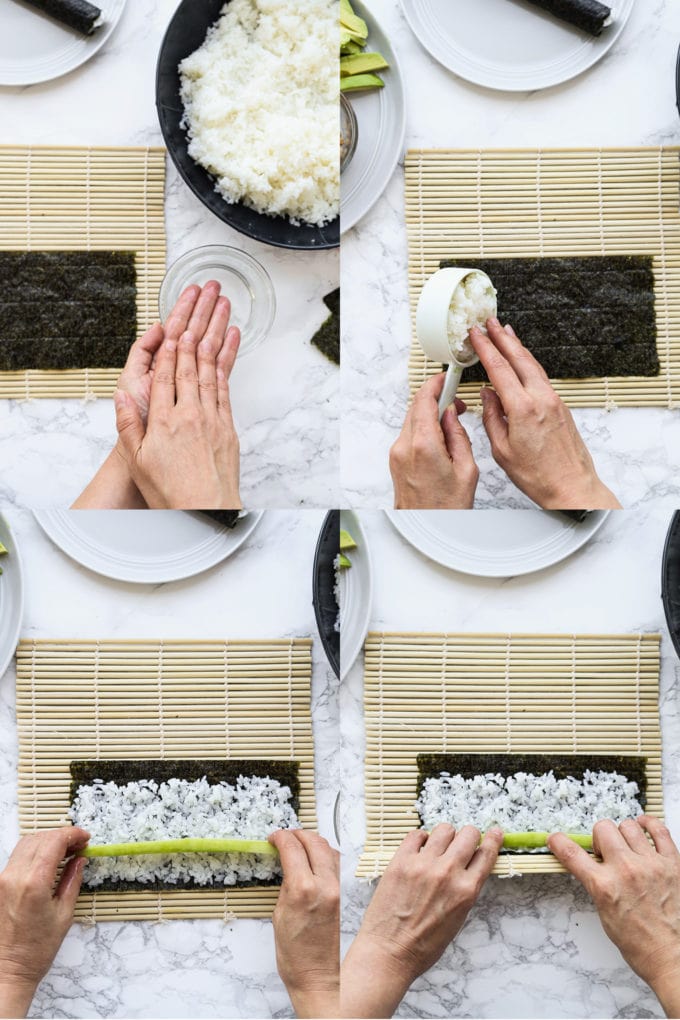
What to Serve with Maki Sushi
Now that you have a colorful plate of maki sushi, it’s time to serve it with other yummy Japanese dishes. For a traditional Japanese dinner, serve these rolls with:
Japanese desserts:
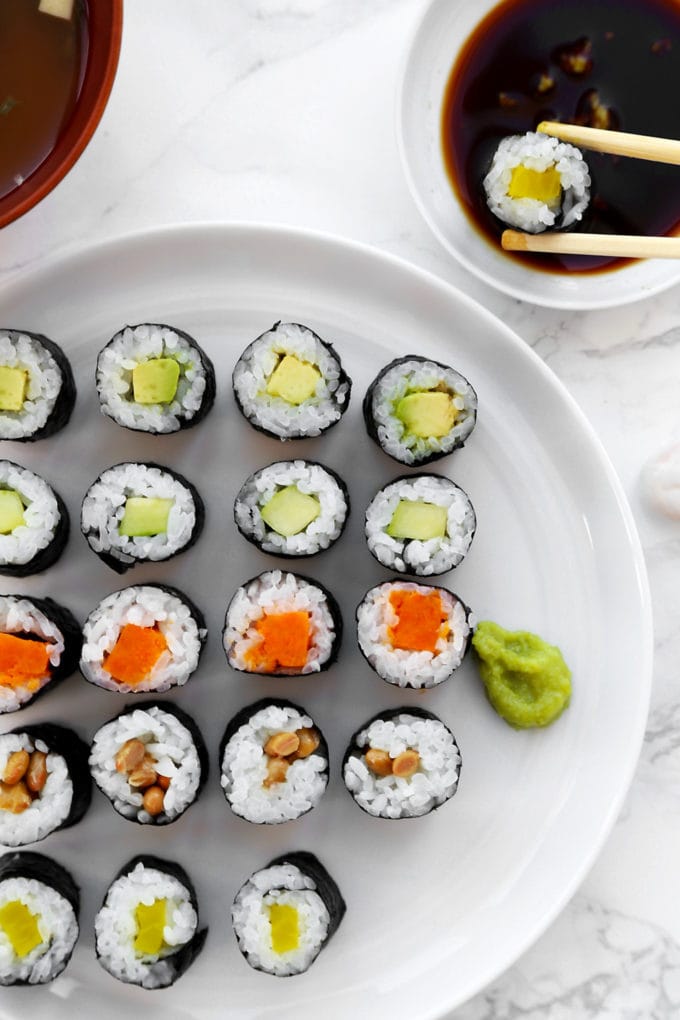
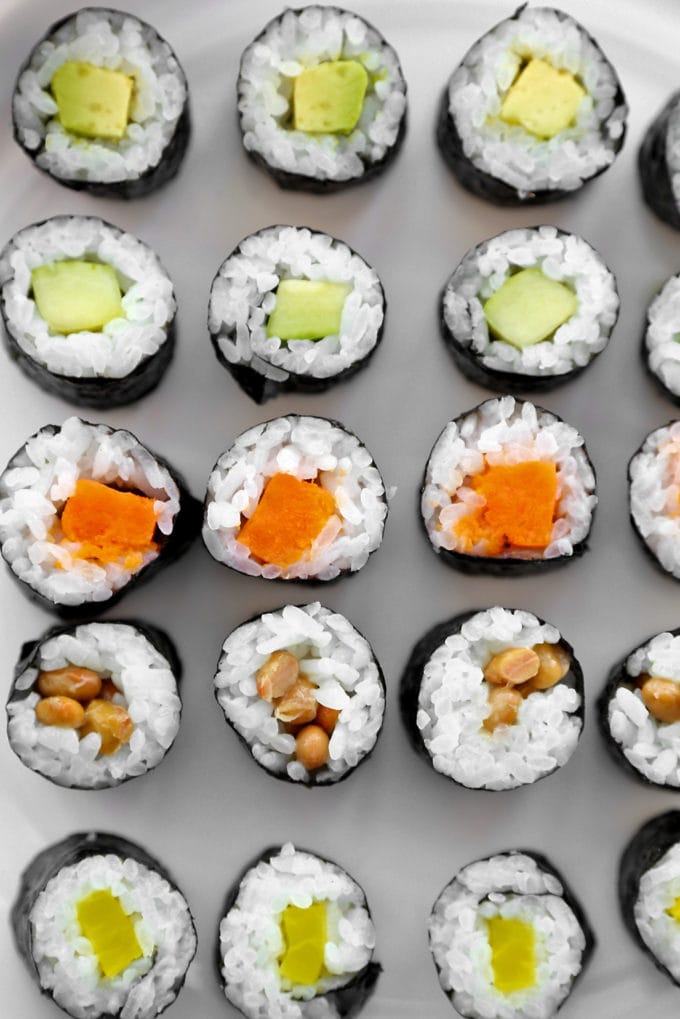
Did you like this Maki Sushi Recipe? Are there changes you made that you would like to share? Share your tips and recommendations in the comments section below!
Print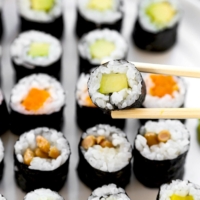
Maki Sushi
- Prep Time: 30 minutes
- Cook Time: 20 minutes
- Total Time: 50 minutes
- Yield: 8 rolls 1x
- Category: Rice
- Cuisine: Japanese
- Diet: Vegetarian
Description
Light and filled with various fillings, these mini sushi rolls are sure to become a new favorite in your kitchen!
Ingredients
- 4 cups sushi rice - visit my post on how to make sushi rice
Filling options (you can of course use other fillings of your choice, these are basic ones):
- Persian or Kirby cucumber, cut into 1/2-inch long strips
- Takuan (pickled daikon radish), cut into 1/2-inch long strips
- Avocado, pitted, cut into 1/2-inch long strips
- Cooked sweet potato (don't overcook it to the point where it's mushy), cut into 1/2-inch long strips.
- Natto (1 box)
- Sashimi grade tuna, salmon, or yellowtail (about 5 oz for 8 rolls), cut into 1/2-inch long strips
Other:
- 4 nori sheets
- Soy sauce, for dipping
- Wasabi (optional)
- Pickled ginger (optional)
Instructions
- Place the bamboo mat on a flat surface, facing you (you will be rolling the mat away from you). Fill a small bowl with 1/2 cup tepid water and 1 tablespoon rice vinegar. Place it next to the bamboo mat.
- Slice the nori sheets in half, lengthwise, and place on a plate next to the bamboo mat.
- Grab a nori sheet and place it on the bamboo mat’s edge closer to you, lengthwise, leaving 1” of bamboo space visible, shiny face down.
- Dip your fingers in the dipping bowl and moisten your hands. Grab 1/2 cup of sushi rice (using a measurement cup is the easiest to measure the rice) and place it on the nori sheet. Don’t overfill the cup or press the rice down, just scoop the rice as you normally would scoop any other grain.
- Spread the rice evenly across the sheet, leaving 1” of space free at the top of the nori sheet.
- Place the filling in the center of the rice, across lengthwise. Grab the bottom edges of the mat with your thumbs while holding on to the toppings with your other fingers. Roll it into a tight cylinder, tucking the fillings in firmly.
- Roll it forward while using a little pressure but not so much that the filling spills out. Let go of the mat when you get to the other end.
- Wipe a kitchen knife with vinegar water and evenly cut the roll into bite size pieces.
- Serve with soy sauce, wasabi, and pickled ginger on the side.
Notes
Maki sushi taste best when the rice is fresh and at room temperature. But you can refrigerate the leftovers in an airtight storage containers if it’s absolutely necessary. Eat cold – do not reheat!
Nutrition
- Serving Size: 1 roll
- Calories: 150
- Sugar: 3.3g
- Sodium: 303mg
- Fat: 1.5g
- Saturated Fat: 0.2g
- Unsaturated Fat: 0.2g
- Trans Fat: 0g
- Carbohydrates: 30.8g
- Fiber: 0.7g
- Protein: 2.5g
- Cholesterol: 0.1mg
